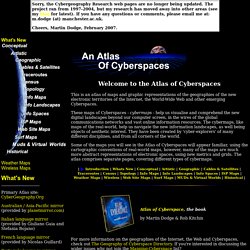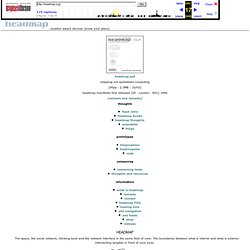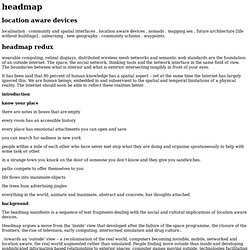

Biota.org: The Artificial Life Project.
Thingiverse. An Atlas of Cyberspaces. This is an atlas of maps and graphic representations of the geographies of the new electronic territories of the Internet, the World-Wide Web and other emerging Cyberspaces.

These maps of Cyberspaces - cybermaps - help us visualise and comprehend the new digital landscapes beyond our computer screen, in the wires of the global communications networks and vast online information resources. The cybermaps, like maps of the real-world, help us navigate the new information landscapes, as well being objects of aesthetic interest. They have been created by 'cyber-explorers' of many different disciplines, and from all corners of the world.
Some of the maps you will see in the Atlas of Cyberspaces will appear familiar, using the cartographic conventions of real-world maps, however, many of the maps are much more abstract representations of electronic spaces, using new metrics and grids. The atlas comprises separate pages, covering different types of cybermaps. (© Copyright - Martin Dodge, 2007.
Panopticism. Keynote address for "Earth to Avatars"26 October 1996 Mark Pescempesce@netcom.com Part One: A Brief History of the Virtual Word What is interesting is that we’ve never envisioned cyberspace as anything but a social space.

Gibson’s Matrix was filled with users - legal and illegal - AI’s and, when it changed, the Loa of Voudon. Gibson dreams his tech but Stephenson has it down cold; so everything in the Matrix is perfect, while The Street, populated with barbies and low-rez avatars gave us a real direction, a real vision. The success of The Palace and Alphaworld - which must be admitted as immature technologies - proves the existence of a powerful drive to connect. Because connection is the only thing in that space is real, the only thing that persists after the servers go down and the networks jam up.
An avatar, then, serves one purpose above all - as a vehicle of communication. Part Two: Self in Cyberspace What does this digital incarnation of the self communicate? Cyberspace: First Steps. We Feel Fine. Headmap. Headmap.pdf mapping out spatialised computing [95pp : 2.3MB : 10/03] headmap manifesto first released [SF : London : NYC] 1999 [reviews and remarks]

Headmap Redux. Location aware devices localisation . community and spatial interfaces . location aware devices . nomads . mapping sex . future architecture [life without buildings] . unlearning . new geography . community schisms . waypoints headmap redux wearable computing, retinal displays, distributed wireless mesh networks and semantic web standards are the foundation of an outside internet.

The space, the social network, thinking tools and the network interface in the same field of view. The boundaries between what is interior and what is exterior intersecting tangibly in front of your eyes. It has been said that 80 percent of human knowledge has a spatial aspect – yet at the same time the Internet has largely ignored this. Introduction know your place there are notes in boxes that are empty every room has an accessible history every place has emotional attachments you can open and save you can search for sadness in new york paths compete to offer themselves to you life flows into inanimate objects 3).
Global Consciousness Project. Poietic Generator. Electric Sheep. Automate the Web · Zapier.